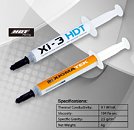Friday, March 1st 2013

XIGMATEK Also Announces Xi-3 HDT Thermal Compound
In addition to the Dark Knight Frostbourne Edition CPU cooler, XIGMATEK announced the new Xi-3 HDT thermal compound optimized for CPU coolers with heatpipe direct touch (HDT) bases. In such a base, heatpipes of the cooler make direct contact with the CPU, and are nested inside grooves of the base. Gaps between the base and the heat pipes tend to reduce surface area of contact between the cooler and the CPU. By design, HDT bases are less "polished," it helps to have a thermal compound that can seep into to surface irregularities better.
The Xi-3 HDT from XIGMATEK is advertised to have smaller particle size, while making up with higher density. The company didn't specify the composition of the compound, but detailed its characteristics. Its viscosity is rated at 104 Pa·s, specific gravity at 2.5 g/cm³, and an impressive 9.1 W/mK thermal conductivity. As with most performance TIMs on the market, it features an anti-bleed composition, isn't electrically conductive, and has an applied life rated at 10 years. It is sold in 4 g syringes, the company did not reveal pricing.
The Xi-3 HDT from XIGMATEK is advertised to have smaller particle size, while making up with higher density. The company didn't specify the composition of the compound, but detailed its characteristics. Its viscosity is rated at 104 Pa·s, specific gravity at 2.5 g/cm³, and an impressive 9.1 W/mK thermal conductivity. As with most performance TIMs on the market, it features an anti-bleed composition, isn't electrically conductive, and has an applied life rated at 10 years. It is sold in 4 g syringes, the company did not reveal pricing.

5 Comments on XIGMATEK Also Announces Xi-3 HDT Thermal Compound
Dispite the claims, TIM in between the heat pipes does not increase cooling unless the heatsink/heatpipe design is really inferior in which case you should buy a proper HSF. The aluminum plate holding the exposed heatpipes against the CPU/GPU heatspreader is not a real source of thermal cooling, the heatpipes are. TIM in between the heatpipes doesn't produce any significant heat transfer compared to the direct contact of the heatpipes against the CPU/GPU heat spreader.
In fact most people use 10x or more TIM than they should use. TIM is a thermal insulator. If when you apply it you can't see thru the TIM like it's translucent, you're using way too much TIM. If when you remove the HSF after it has been installed with the thinnest layer of TIM you can manage, you don't see mostly bare spots on the heatpipes/heatsink and CPU/GPU heat spreader where the two metal surfaces have touched and squeezed the excess TIM out, then you're using way too much TIM. TIM is only intended to fill the minute scratches and imperfections in the two metal surfaces. More TIM is BAD and insulates the CPU/GPU from the heatsink, which makes it run hotter. Hell mayonnaise actually works pretty good in a pinch and it's cheap.
If 1-2C changes your life then you'll need to test the top 15+ TIMs to find out which one works 1-2C better than the rest with your components, if in fact there is 1-2C difference between the top 15-20 TIMs.
If you improper use any TIM you're likely to get poor results. TIM is intended to fill the micro surface imperfections only. It's not thermal epoxy though the way most people use it, you'd think it improves thermal conduction compared to metal-to-metal contact - which is does not. A small tube of TIM should last thru at least 25 or more CPU installs. An amount the size of an uncooked grain of rice is plenty and may still be way too much depending on the viscosity of the TIM.
As previous noted any of the top 20+ TIMs will produce virtually the same temps with two degrees C. Anyone living or dying over 2C needs professional help for their condition. ;)
And I also lap every heatsink I own, even old ones I find from old PCs in case I need to use them somewhere on a future project. Without this step, the quality of TIM would probably be more measurable in the temperature results.
To sum it up, if your contact points are both flat and the mountint pressure is enough to sufficiently spread any excess TIM from between the two surfaces then go with just about any TIM on the market (even use the conductive stuff if you know what you are doing). If you can't waste time making sure the two above are met then spend a bit more on the quality stuff.